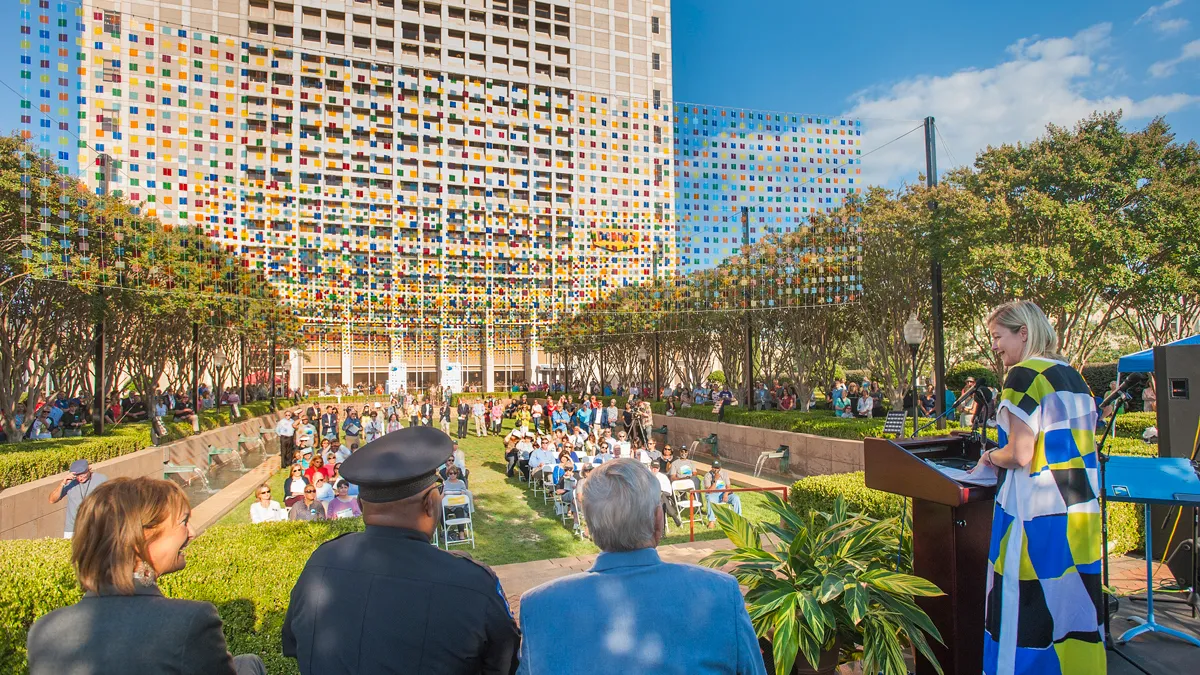UPDATE, July 18, 2018: Bloomberg Philanthropies today announced 14 finalists eligible to receive up to $1 million in funding from the 2018 Public Art Challenge. The finalists are:
| City | Project |
|---|---|
| Anchorage, AK | Addressing Energy Policy and Economic Development |
| Austin, TX | Promoting Cultural Equity |
| Baltimore, MD | Enhancing Public Safety by Reducing Violence |
| Camden, NJ | Transforming Illegal Dumping Lots into Art Spaces |
| Coral Springs, FL | Inspiring Community Healing After Gun Violence |
| El Paso, TX | Strengthening Cross-Border Relations Between the U.S. and Mexico |
| Holyoke, MA | Celebrating Diverse Cultural Identities |
| Honolulu, HI | Shedding Light on Historical Narratives Through Public Art |
| Jackson, MS | Inspiring Dialogue about Food Access |
| Miami-Dade County, FL | Raising Awareness about Climate Change Through Public Art |
| Santa Rosa, CA | Exploring Resiliency and Natural Disaster Recovery |
| Seattle, WA | Illuminating Gentrification and Celebrating Identity |
| St. Louis, MO | Exploring the Legacy of Displacement |
| Tulsa, OK | Reclaiming History Through Public Art |
Bloomberg Philanthropies says it will select at least three winners from the group of finalists in the fall. Those winners will be given funds to execute their projects over a maximum of two years.
Dive Brief:
- Bloomberg Philanthropies today announced the 2018 Public Art Challenge, a competition that allows U.S. cities with 30,000 residents or more to apply for up to $1 million in funding for "temporary public art projects that address important civic issues."
- The first Public Art Challenge, launched in 2014, prompted submissions of art projects that addressed topics including neighborhood safety, environmental sustainability and city identity. The inaugural challenge generated $13 million for local communities and employed more than 800 people in full-time and part-time positions.
- The 2018 project proposals will be evaluated on their capacity to enable public-private collaborations, strengthen local economies and celebrate creativity. Three winners will receive grants to execute projects over the course of two years.
Dive Insight:
Previous Public Art Challenge winners, including Los Angeles and Spartanburg, SC, executed eye-catching works of art that helped to transform underutilized spaces. In 2015, Gary, IN launched culinary installation "ArtHouse: A Social Kitchen," while the New York cities of Albany, Schenectady and Troy received funding for a collaborative project dubbed "Breathing Lights" that illustrated human breath to "elevate the issues of vacancy and urban revitalization," according to a press statement.
While to some, promoting creativity through visual art installations does not permit a "smart city" identification, efforts like the Public Art Challenge actually push cities to promote urban identity in a way that cannot be done through most typical smart city initiatives. In a 2017 interview with Smart Cities Dive, Jason Schupbach, director of the Design School at Arizona State University's Herberger Institute for Design and the Arts, explained that using art to tackle problems is called "creative placemaking," and it can be folded into most smart city projects to become a crucial element of city improvement.
"There's definitely artists working on public safety projects. There's artists working on transit projects. There's artists working on environmental projects. The skill set of artists really do translate into helping a lot of those different sectors," he said.
Efforts such as the Public Art Challenge are important for keeping culture and creativity alive in urban areas that are often so saturated by automation and technology. Michael Bloomberg, founder of the overarching American Cities Initiative, touted the challenge as a way for cities to address issues "from new perspectives," and it is hopeful that the cities that do not win — or even apply — to the challenge will still fold creative placemaking into smart city enterprises.











